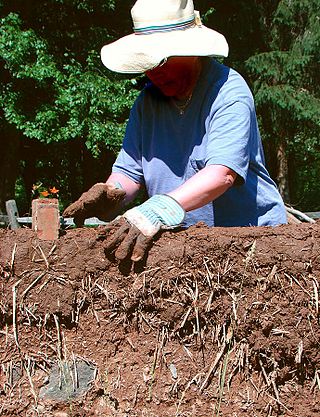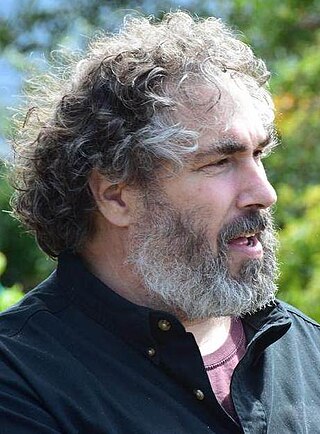Related Research Articles
An autonomous building is a building designed to be operated independently from infrastructural support services such as the electric power grid, gas grid, municipal water systems, sewage treatment systems, storm drains, communication services, and in some cases, public roads.
Kerosene, or paraffin, is a combustible hydrocarbon liquid which is derived from petroleum. It is widely used as a fuel in aviation as well as households. Its name derives from Greek: κηρός (kērós) meaning "wax", and was registered as a trademark by Canadian geologist and inventor Abraham Gesner in 1854 before evolving into a generic trademark. It is sometimes spelled kerosine in scientific and industrial usage.

Falafel is a deep-fried ball or patty-shaped fritter of Egyptian origin, featuring in Middle Eastern cuisine, particularly Levantine cuisines, and is made from broad beans, ground chickpeas, or both.

Vicia faba, commonly known as the broad bean, fava bean, or faba bean, is a species of vetch, a flowering plant in the pea and bean family Fabaceae. It is widely cultivated as a crop for human consumption, and also as a cover crop. Varieties with smaller, harder seeds that are fed to horses or other animals are called field bean, tic bean or tick bean. Horse bean, Vicia faba var. equinaPers., is a variety recognized as an accepted name. This legume is very common in Southern European, Northern European, East Asian, Latin American and North African cuisines.

A hypocaust is a system of central heating in a building that produces and circulates hot air below the floor of a room, and may also warm the walls with a series of pipes through which the hot air passes. This air can warm the upper floors as well. The word derives from the Ancient Greek hypo meaning "under" and caust-, meaning "burnt". The earliest reference to such a system suggests that the temple of Ephesus in 350 BC was heated in this manner, although Vitruvius attributes its invention to Sergius Orata in c. 80 BC. Its invention improved the hygiene and living conditions of citizens, and was a forerunner of modern central heating.

Cob, cobb, or clom is a natural building material made from subsoil, water, fibrous organic material, and sometimes lime. The contents of subsoil vary, and if it does not contain the right mixture, it can be modified with sand or clay. Cob is fireproof, resistant to seismic activity, and uses low-cost materials, although it is very labour intensive. It can be used to create artistic and sculptural forms, and its use has been revived in recent years by the natural building and sustainability movements.

The Coquille River is a stream, about 36 miles (58 km) long, in southwestern Oregon in the United States. It drains a mountainous area of 1,059 square miles (2,740 km2) of the Southern Oregon Coast Range into the Pacific Ocean. Its watershed is between that of the Coos River to the north and the Rogue River to the south.

A central heating system provides warmth to a number of spaces within a building from one main source of heat. It is a component of heating, ventilation, and air conditioning systems, which can both cool and warm interior spaces.

The Rumford fireplace is a tall, shallow fireplace designed by Sir Benjamin Thompson, Count Rumford, an Anglo-American physicist best known for his investigations of heat. Its shallow, angled sides are designed to reflect heat into the room, and its streamlined throat minimizes turbulence, thereby carrying away smoke with little loss of heated room air.

Natural building is the construction of buildings using systems and materials that emphasize sustainability. This in turn implies durability and the use of minimally processed, plentiful or renewable resources, as well as those that, while recycled or salvaged, produce healthy living environments and maintain indoor air quality. Natural building tends to rely on human labor, more than technology. As Michael G. Smith observes, it depends on "local ecology, geology and climate; on the character of the particular building site, and on the needs and personalities of the builders and users."
Rice-hull bagwall construction is a system of building, with results aesthetically similar to the use of earthbag or cob construction. Woven polypropylene bags are tightly filled with raw rice-hulls, and these are stacked up, layer upon layer, with strands of four-pronged barbed wire between. A surrounding "cage" composed of mats of welded or woven steel mesh on both sides and then stuccoed, to form building walls.

Superinsulation is an approach to building design, construction, and retrofitting that dramatically reduces heat loss by using much higher insulation levels and airtightness than average. Superinsulation is one of the ancestors of the passive house approach.

A masonry heater is a device for warming an interior space through radiant heating, by capturing the heat from periodic burning of fuel, and then radiating the heat at a fairly constant temperature for a long period. Masonry heaters covered in tile are called cocklestoves. The technology has existed in different forms, from back into the Neoglacial and Neolithic periods. Archaeological digs have revealed excavations of ancient inhabitants utilizing hot smoke from fires in their subterranean dwellings, to radiate into the living spaces. These early forms have evolved into modern systems.

Light clay is a natural building material used to infill between a wooden frame in a timber framed building using a combination of clay and straw, woodchips or some other lighter material.

A rocket mass heater (RMH), also known as rocket stove mass heater, is a form of slow-release radiant heating system, designed to primarily heat people and secondarily to warm areas in line of sight around it. Variations of RMH can also be extended for the functions of cooking, heating water, and producing warm air for distribution.

Jean-Louis Bourgeois was an American author and the son of artist Louise Bourgeois and art historian Robert Goldwater. Bourgeois studied literature and architectural history at Harvard University.
Low-impact development (LID) has been defined as "development which through its low negative environmental impact either enhances or does not significantly diminish environmental quality".

Paul Wheaton is an American permaculture author, master gardener, software engineer, and disciple of the natural agriculturist Sepp Holzer. He is known for writing his book, "Building a Better World in Your Backyard", founding Permies, the largest website devoted to permaculture, as well as for creating and publishing articles, videos, and podcasts on the subject of permaculture.
Ernie and Erica Wisner are a couple from Tonasket, Washington, United States, best known for their innovative rocket mass heater designs. They are often referred to as the worldwide leaders and trainers in rocket stove technology. They have made over 700 rocket stoves all over the world.

Michael James Murphy was an American master builder in the Carmel-by-the-Sea, California. He had a significant influence on the character and architecture of the Village of Carmel. From 1902 to 1940, he built nearly 350 buildings. He founded M. J. Murphy, Inc., which continues to supply building material for the Monterey Peninsula.
References
- ↑ Ianto Evans; Linda Smiley; Michael G. Smith; Michael Smith (1 June 2002). The Hand-Sculpted House: A Philosophical and Practical Guide to Building a Cob Cottage. Chelsea Green Publishing. pp. xvii–. ISBN 978-1-890132-34-7 . Retrieved 16 July 2013.
- ↑ "Made in Mud." Resurgence 182, 1997: 46–47
- 1 2 Lapriore, Elaine Beebe (22 October 2000). "Oregon Couple Rediscover Ancient Building Method". Yakima Herald - Republic.
- ↑ Salomon, Shay (1 May 2007). "How Large Is This House?!". Natural Life: 22–23.
- ↑ Roy, Rob (2003). Cordwood Building: The State of the Art. Gabriola Island, BC: New Society Publishers. ISBN 978-1-55092-467-1.
- ↑ Baker-Laporte, Paula; Elliott, Erica; Banta, John (2008). Prescriptions for a Healthy House a Practical Guide for Architects, Builders & Homeowners (3rd ed.). New York: New Society Publishers. ISBN 978-1-55092-410-7.
- ↑ Huyser-Honig, Joan (February 1992). "The Fava Bean Project". Horticulture. 70 (2).
- ↑ Kaplan, Rachel; Blume, K. Ruby (27 April 2011). Urban Homesteading: Heirloom Skills for Sustainable Living. New York: Skyhorse Pub. ISBN 978-1-61608-054-9.